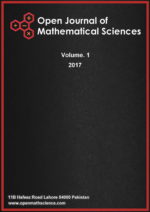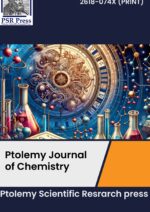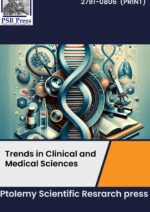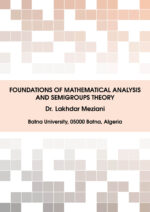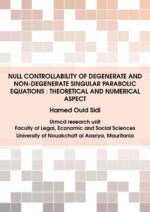Ptolemy Scientific Research Press (PSR Press)is a highly regarded publisher of scientific literature dedicated to bringing the latest research and findings to a broader audience. With a focus on cutting-edge research and technology, Ptolemy Scientific Research Press offers a range of publications catering to professionals, researchers, and student’s needs. Whether looking for information on the latest breakthroughs in physics, biology, engineering, or computer science, you can trust Ptolemy Scientific Research Press to deliver insightful, accurate, and engaging content. With its commitment to quality, accessibility, and innovation, Ptolemy Scientific Research Press is an essential resource for anyone interested in science and technology.

Latest Published Articles
OJC-Vol. 4 (2021), Issue 1, pp. 27 – 35 Open Access Full-Text PDF
Ulises G. Castillo, Sofía Hernández, Melissa Morataya, Keny Núñez, Freddy A. Carranza, Morena L. Martínez and Marvin J. Núñez
Abstract:Medicinal plant’s quality and safety are becoming a great interest topic worldwide, especially due to contamination with heavy metals. The main objective of this study is to determine the phytochemical composition and quantify the concentration of heavy metals, trace and macro elements in fourteen medicinal plants purchased in the Central Market of San Salvador. Samples were dried and fractionated, subsequently digested and analyzed at first by phytochemical screening and then by atomic absorption spectrometry. The concentration of twelve elements was determined, only Matricaria chamomilla exceeded the established World Health Organization limit for Cd and Cu. Acourtia nudicaulis and Turnera diffusa exceeded the permitted concentration of Ni. The concentration of these elements must be inspected in medicinal plants sold in the informal markets of El Salvador to ensure the safety and quality. To our knowledge, this is the first study of heavy metals in medicinal plants conducted in El Salvador.
OJC-Vol. 4 (2021), Issue 1, pp. 19 – 26 Open Access Full-Text PDF
Musarat Jabeen, Namra Hussain, Hira Noreen, Iqra Amjad, Amna Zia, Maria Manzoor, Komal Ashraf, Rabia Mehmood
Abstract:Due to the beneficial effects of anthocyanins on plants, animals and human beings, they have become the most interesting topic of research for scientists. They are being used in food industry as well as in pharmaceutical and cosmetic industries. Anthocyanins are present in red, blue, orange, purple, violet and intermediate color mostly. They are non-hazardous natural pigments that have positive impact on human health. They occur in nature since the evolution of flowering plants on earth. As humans were wild in ancient times, they consumed their large concentration through their diet and human digestive system is very active for their digestion. In this review, the chemistry and impact of anthocyanins on human health is discussed briefly.
OMA-Vol. 5 (2021), Issue 2, pp. 66 – 72 Open Access Full-Text PDF
Serife Müge Ege, Fatma Serap Topal
Abstract:This work deals with a boundary value problem for a nonlinear semipositone multi-point fractional differential equation. By using the Schauder fixed point theorem, we show the existence of one solution for this problem. Our result extend some recent works in the literature.
OMA-Vol. 5 (2021), Issue 2, pp. 53 – 65 Open Access Full-Text PDF
Janet Kwakye, J. M. Tchuenche
Abstract:A two-strain model of the transmission dynamics of herpes simplex virus (HSV) with treatment is formulated as a deterministic system of nonlinear ordinary differential equations. The model is then analyzed qualitatively, with numerical simulations provided to support the theoretical results. The basic reproduction number \(R_0\) is computed with \(R_0=\text{max}\lbrace R_1, R_2 \rbrace\) where \(R_1\) and \(R_2\) represent respectively the reproduction number for HSV1 and HSV2. We also compute the invasion reproductive numbers \(\tilde{R}_1\) for strain 1 when strain 2 is at endemic equilibrium and \(\tilde{R}_2\) for strain 2 when strain 1 is at endemic equilibrium. To determine the relative importance of model parameters to disease transmission, sensitivity analysis is carried out. The reproduction number is most sensitive respectively to the contact rates \(\beta_1\), \(\beta_2\) and the recruitment rate \(\pi\). Numerical simulations indicate the co-existence of the two strains, with HSV1 dominating but not driving out HSV2 whenever \(R_1 > R_2 > 1\) and vice versa.
ODAM-Vol. 4 (2021), Issue 3, pp. 60 – 71 Open Access Full-Text PDF
Xiaojing Wang, Zhen Lin, Lianying Miao
Abstract:In this paper, we obtain the quantitative calculation formula of the degree-based topological indices of four standard product for the path and regular graphs, which unify to solve the question on product of these basic graphs without having to deal with it one by one separately. As applications, we give corresponding calculation formula of the general Randić index, the first general Zagreb index and the general sum-connectivity index.
ODAM-Vol. 4 (2021), Issue 3, pp. 36 – 59 Open Access Full-Text PDF
Benedikt Valentin Meylahn, Jan Harm van Vuuren
Abstract:The temporal dynamics of games have been studied widely in evolutionary spatial game theory using simulation. Each player is usually represented by a vertex of a graph and plays a particular game against every adjacent player independently. These games result in payoffs to the players which affect their relative fitness. The fitness of a player, in turn, affects its ability to reproduce. In this paper, we analyse the temporal dynamics of the evolutionary 2-person, 2-strategy snowdrift game in which players are arranged along a cycle of arbitrary length. In this game, each player has the option of adopting one of two strategies, namely cooperation or defection, during each game round. We compute the probability of retaining persistent cooperation over time from a random initial assignment of strategies to players. We also establish bounds on the probability that a small number of players of a particular mutant strategy introduced randomly into a cycle of players which have established the opposite strategy leads to the situation where all players eventually adopt the mutant strategy. We adopt an analytic approach throughout as opposed to a simulation approach clarifying the underlying dynamics intrinsic to the entire class of evolutionary spatial snowdrift games.

